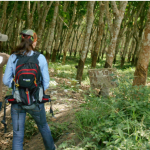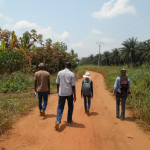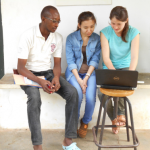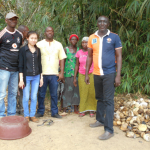Risk of Vector-borne Diseases in Relation to Rubber Plantations in Côte d’Ivoire as compared to Lao PDR
Project leader: Dr. Paul Brey and Pr. Mireille Dosso
Member of staff: Julie-Anne Tangena, Dr. Bernard Kouadio Allali, Dr. Ibrahima Zanakoungo Coulibaly, Issouf Traoré and Dr. Phoutmany Thammavong
Funded by: The Michelin Foundation
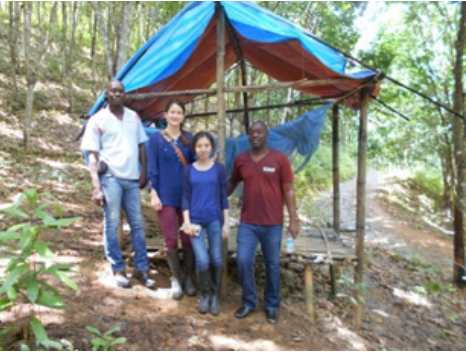
Background:
In March 2013 we started the ECOMORE project on risk of vector-borne diseases in relation to rubber plantations in Lao PDR. This study is of importance in Lao PDR where an estimated 300,000 people will work in rubber plantations in the near future. Mosquitoes were collected using a double bed net method in Luang Prabang province in four different habitats; secondary forest, immature plantation, mature plantation (yielding latex) and village. A total of 19,466 mosquitoes were collected and identified in 5 months in the four different habitats, consisting of 113 different species. Of these mosquitoes 1,641 possible dengue and chikungunya vectors and 250 possible malaria vectors were collected in the rubber plantation. We therefore identified putative malaria and dengue vectors are present in the rubber plantations. This indicates the possibility of vector-borne disease transmission occurring in the plantations and showed us the times during the day and during the year when risks of exposure were highest for the workers and their families. Using this information we can advise a proper vector control method for the rubber workers to decrease their risk of vector-borne diseases.
While doing this study we realized the data we were collecting is not only interesting for Asia, but could also be of importance in other continents where a lot of rubber plantations are present and many vector-borne diseases occur. It is known that malaria is actively transmitted in and around rubber plantations in Côte d’Ivoire and it is of vital importance to understand the behavior of these mosquitoes in the rubber plantation area to advice a proper control method. Not only that, comparing the data of this mirror study with data from Lao PDR will give us a more comprehensive knowledge of the mosquito ecology and their behavior in rubber plantations. This generalization can help protect staff working in rubber plantations all over the world.
Rationale
Areas of West Africa, such as Côte d’Ivoire, have extensive natural rubber production. We anticipate that the changes in the environment to rubber cultivation will result in an altered risk from vector-borne diseases for the workers, their families and surrounding villages; predominantly malaria and yellow fever, but also arboviral diseases such as dengue and chikungunya. This study will provide an opportunity to further develop the entomological department at Institut Pasteur de Côte d’Ivoire whilst deepening our understanding of the vector ecology in rubber plantations in West Africa. It is envisaged that this project will allow us to advise different governmental and health organizations how to decrease vector-borne disease incidence in rubber plantation areas where active transmission of vector-borne diseases already occur. Furthermore this data will be combined with data collected in a similar way in Lao PDR to write a comprehensive document about the vector-borne disease risks for rubber workers. This study will be of relevance to public health workers, governments and those working in the rubber industries of Côte d’Ivoire, other countries in West Africa and South-East Asia.
Overall goal: To assess the potential risk of vector-borne disease infections occurring in and around rubber plantations
Objectives:
+ Determine the risk of mosquito-borne diseases like malaria, yellow fever, dengue and chikungunya arising in rubber plantations compared to surrounding villages
+ Understand when and where rubber plantation workers are exposed to the vector mosquitoes
+ Provide advice on how to decrease exposure of rubber plantation workers and their families to vector-borne diseases
+ Understand the differences and similarities between Laos and Côte d’Ivoire in vector-borne disease risk for rubber plantation
Methods
The project officially started in 2015 and is currently in the start-up phase. No data has been collected yet, with work still in the preparatory phase.
Field sites selection
During two visits to Côte d’Ivoire by the Lao team (March 2014 and February 2015), the Ivorian and Lao team tried to identify suitable field sites by visiting together several rubber plantation areas close to Abidjan city. We tried to find three villages surrounded by mature and immature rubber plantation and one large village without any rubber plantation in the area. After visiting several sites, four study areas with three habitats were selected (table 1). The three study areas Agnimangbo, Adangba-Eby and Kotokodji consist of a small village surrounded by rubber plantations. In these study areas entomological surveys will be conducted in the village, in the surrounding immature rubber plantation (i.e. not tapped for latex) and in the surrounding mature rubber plantation (i.e. tapped for latex for at least 10 years). In Lopou, a large village without rubber plantations, entomological surveys will be conducted in three sites. These three sites within Lopou village will serve as the control to understand the difference in risk of mosquito-borne diseases.
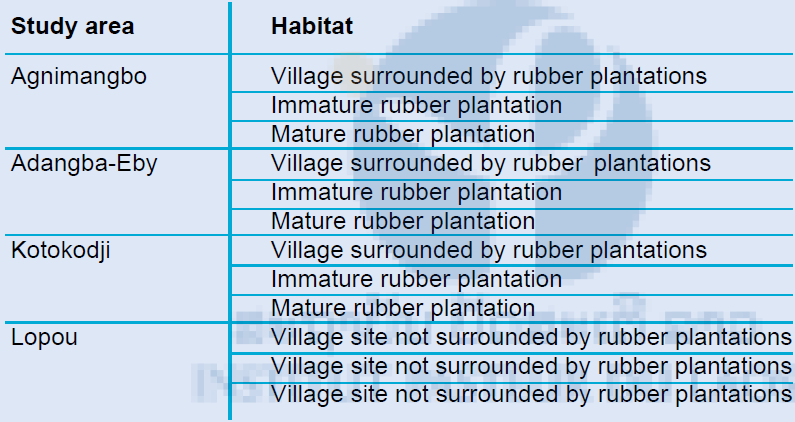
Table 1: Study sites of the Yersin project: the four study areas with three habitats
Rapid rural appraisals
Before the start of the entomological survey a rapid rural appraisal will be conducted in all four villages to understand the behavior and attitude of the villagers towards vector-borne diseases. This method enables our team members to introduce our project and involve villagers, by asking them to share their opinions and ideas on vector-borne diseases in an interactive way. These appraisals will also be used to get a village layout and an overview of the areas in the village with high number of mosquitoes.
Human-baited double net collections
Adult mosquitoes will be collected in the three habitats of our four study areas using the human-baited double net collection method. Participants are positioned on a bed, protected from mosquito bites using a bed net. A second bigger bed net is hung over the small bed net with a gap at the bottom (Figure 1). Through this gap between the two bed nets mosquitoes attracted to the participant enter and are caught. Every hour the participant inside the small bed net collects the mosquitoes in between the bed nets for 10 minutes. Mosquitoes collected with the human-baited double net method are frozen and identified to species.
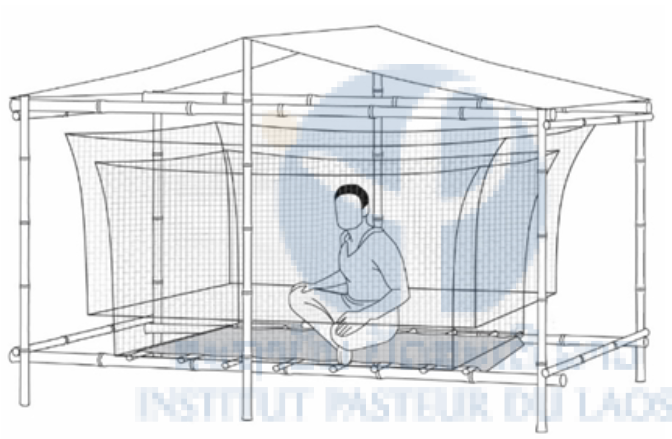
Figure 1: Schematic overview of the human baited double net trap
Parity status of vector mosquitoes
To understand the longevity of the vector mosquitoes and therefore their vectorial capacity, the vector mosquitoes collected with the human-baited double net method will be analyzed for parity. The ovaries of the important dengue, yellow fever and malaria vectors are dissected and identified to parous or nulliparous ovaries. Every season (rainy or dry) at least 100 mosquitoes of each vector species will be dissected. This includes, if present, the mosquito species Aedes albopictus, Aedes aegypti, Anopheles gambiae s.l. and Anopheles funestus.
Quick seasonal survey
Our entomological survey needs to be related to human behavior for analysis of vector-borne disease risk. We will therefore collect the human behavior data using quick seasonal surveys in all four villages. Questions will be asked about their mosquito protection behavior and their activities the day before the survey in a seven minute long questionnaire. The survey will be conducted on a predetermined number of randomly chosen villagers and rubber workers (to be determined later using household data) every season. This seasonal behavioral data of villagers and rubber workers will be related to the seasonal entomological data.
Health and environment data
Data on disease prevalence, environmental description and weather needs to be collected from the health and agricultural department of the Ivorian government. As there is huge amount of data available, a new SOP is currently being written to clearly define which data we would need and how we could receive this data from departments within the government. Furthermore, in the SOP we detail how this data would be integrated in our analysis and results.
Communication
We will provide a three-monthly newsletter with a general update of the project, a road map with our accomplishments so far and a scientific update. In January 2016, the Michelin Corporate Social Responsibility team will visit the project in Côte d’Ivoire both in the field sites and in the entomology laboratory in Abidjan.
Future activities
1. Receive equipment for the field laboratory
2. Conduct Rapid Rural Appraisals in all four study villages
3. Start the human-baited double net collections in the four villages with a total of 12 collection sites
4. Conduct parity study on vector mosquitoes collected
5. Conduct the quick seasonal survey in the four villages

